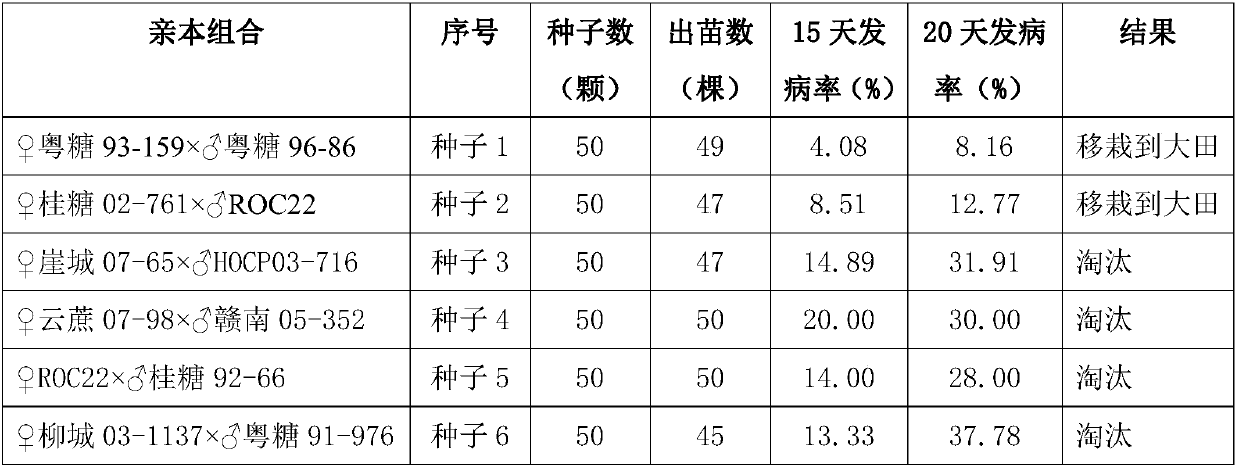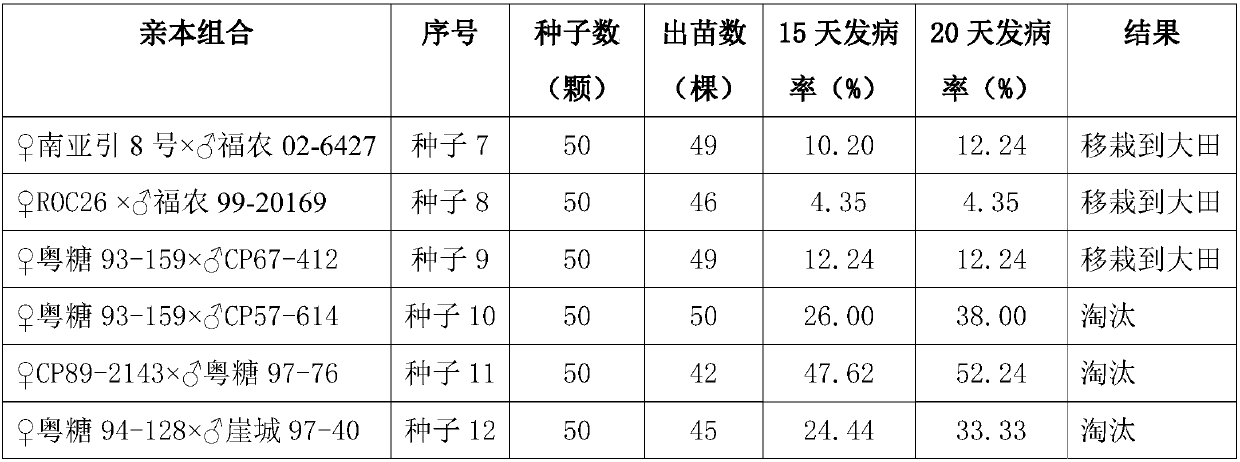Breeding method of hybridization strain of top-rot-resisting sugarcanes
A technology for tip rot and sugarcane tip rot, which is applied in the field of breeding of sugarcane hybrid strains resistant to tip rot, can solve the problem of shortening the breeding period for new varieties resistant to tip rot, consuming manpower and material resources, and long breeding cycles, etc. problem, achieve the effect of reducing repeated planting, improving efficiency, and shortening the breeding cycle
- Summary
- Abstract
- Description
- Claims
- Application Information
AI Technical Summary
Problems solved by technology
Method used
Image
Examples
Embodiment 1
[0028] A method for breeding sugarcane hybrid strains resistant to tip rot, comprising the following steps:
[0029] 1. In April in spring, 50 sugarcane hybrid seeds 1 (♀ Yuetang 93-159×♂♂Yuetang 96-86), 50 sugarcane hybrid seeds 2 (♀ Guitang 02-761×♂ROC22), 50 sugarcane hybrid seeds 3 (♀Yacheng 07-65×♂HOCP03-716) 50, sugarcane hybrid seeds 4 (♀Yuncane 07-98×♂Gannan 05-352) 50, sugarcane hybrid seeds 5 (♀ROC22×♂cinnamon sugar 92-66) 50 seeds, sugarcane hybrid seeds 6 (♀ Liucheng 03-1137×♂ Yuetang 91-976) 50 seeds are divided into six groups, mixed with fine sand, so that the seeds are fully dispersed, and spread on the seedlings with sugarcane In the hole pots of the seedling culture substrate, water fully to keep the substrate moist. After 3 to 5 days, the seeds begin to germinate and emerge, and count the number of seedlings after 7 days.
[0030] 2. When the sugarcane seedlings grow to 4 to 5 true leaves, plant them in a hole tray, completely cover the roots of the sugarca...
Embodiment 2
[0040] A method for breeding sugarcane hybrid strains resistant to tip rot, comprising the following steps:
[0041] 1. In autumn and October, 50 sugarcane hybrid seeds 7 (♀Nanyayin 8×♂Funong 02-6427), 50 sugarcane hybrid seeds 8 (♀ROC26×♂Funong 99-20169), 9 sugarcane hybrid seeds (♀Yuetang 93-159×♂CP67-412) 50 pieces, 10 sugarcane hybrid seeds (♀Yuetang 93-159×♂CP57-614) 50 pieces, 11 sugarcane hybrid seeds (♀CP89-2143×♂Yuetang 97 -76) 50 seeds, 12 sugarcane hybrid seeds (♀Yuetang 94-128×♂Yacheng 97-40) 50 seeds are divided into six groups, mixed with fine sand, so that the seeds are fully dispersed, and spread on the seedlings with sugarcane In the hole pots of the seedling culture substrate, water fully to keep the substrate moist, and the seeds begin to germinate after 4 to 5 days, and count the number of seedlings after 7 days.
[0042] 2. When the sugarcane seedlings grow to 4 to 5 true leaves, plant them in a hole tray, completely cover the roots of the sugarcane seedl...
Embodiment 3
[0052] A method for breeding sugarcane hybrid strains resistant to tip rot, comprising the following steps:
[0053] 1. Mix the sugarcane hybrid seeds with fine sand to make the seeds fully disperse, sow them in the hole pots equipped with sugarcane seedling culture substrates, water them adequately, and keep the substrate moist. After 4 to 5 days, the seeds begin to germinate and emerge, 7 The number of seedlings was counted 2 days later.
[0054] 2. When the sugarcane seedlings grow to 4 to 5 true leaves, plant them in a hole tray, completely cover the roots of the sugarcane seedlings with soil, press lightly, water the fixed root water, and place them in a greenhouse with a sunshade net. Remove the sunshade net after the day, and pour water in the morning and evening;
[0055] 3. Preparation of the spore suspension of sugarcane tip rot pathogen: inoculate the sugarcane tip rot pathogen on the improved MM medium, and cultivate it in a constant temperature incubator at 30°C ...
PUM
 Login to View More
Login to View More Abstract
Description
Claims
Application Information
 Login to View More
Login to View More - R&D
- Intellectual Property
- Life Sciences
- Materials
- Tech Scout
- Unparalleled Data Quality
- Higher Quality Content
- 60% Fewer Hallucinations
Browse by: Latest US Patents, China's latest patents, Technical Efficacy Thesaurus, Application Domain, Technology Topic, Popular Technical Reports.
© 2025 PatSnap. All rights reserved.Legal|Privacy policy|Modern Slavery Act Transparency Statement|Sitemap|About US| Contact US: help@patsnap.com


